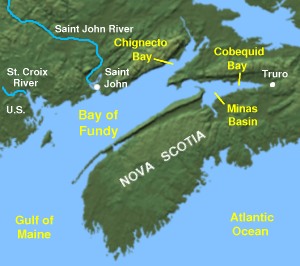20
Feb
Changes to Canadian Aquaculture Rule Raises Pesticide Concerns
(Beyond Pesticides, February 20, 2015) A broad-based coalition is urging Canada’s Prime Minister Stephen Harper to put a stop to proposed changes to federal aquaculture regulations, citing damage to the environment and existing businesses. The proposed amendments to the federal Fisheries Act would exempt the aquaculture industry from provisions that “prohibit the release of deleterious substances into water frequented by fish.”
 Coalition members are worried that the changes will result in pesticides routinely being dumped into the Bay of Fundy, located between the Canadian provinces of Nova Scotia and New Brunswick, and remove Environment Canada’s role in aquaculture activities, said spokeswoman Maria Recchia, the executive director of the Fundy North Fishermen’s Association.
Coalition members are worried that the changes will result in pesticides routinely being dumped into the Bay of Fundy, located between the Canadian provinces of Nova Scotia and New Brunswick, and remove Environment Canada’s role in aquaculture activities, said spokeswoman Maria Recchia, the executive director of the Fundy North Fishermen’s Association.
Aquaculture, which refers to the breeding, rearing, and harvesting of aquatic organisms such as fish, shellfish, and plants, provides half of the world’s seafood. According to Food and Water Watch, offshore aquaculture follows an industrial agriculture model which grows thousands of animals in a confined environment. For fish, however, this confined space is in the ocean, meaning all of the waste products from the operation flow directly into the ocean. This includes excess feed and chemicals that are used, such as antibiotics and pesticides, to treat or prevent disease that occurs when fish are in confinement. Another major concern is the possibility of escaped farmed fish, which can compete with and interbreed with wild fish.
The coalition wrote an open letter to Prime Minister Harper on Tuesday, with 120 signatories, including business leaders, commercial and recreational fishing associations, scientists, lawyers, and environmentalists.”
“In essence, in the end, we are going end up with the aquaculture being essentially self-regulated and self-monitored,” said Recchia, who is based in southwestern New Brunswick.
“And I think we’re going to have a much worse style of management than we have now and it’s going to be a lot more problematic for the marine environment.”
Stewart Lamont, owner of Tangier Lobster in Nova Scotia, agrees. “The value of our industry is based on a pristine, non-polluted marine environment,” Lamont said in a statement.
“We have already dealt with the impacts of pesticides, and see federal fines levied on something that would now become legal. To have DFO authorize pollution from a coastal industry is simply baffling,” he said.
Salmosan, a pesticide formulation containing the active ingredient azamethiphos and currently approved for use in the Bay of Fundy, can be hazardous to lobsters and other species hundreds of meters from a farm. Another pesticide, Alphamax (active ingredient deltamethrin), which was temporarily used to combat a sea-lice infestation five years ago, could kill lobsters up to 10 kilometers, or nearly six miles, away.
The draft changes to the Fisheries Act have been in the works since 2011 and are close to being passed, said Recchia.
“These regulations will set back Canadian aquatic environmental protection measures several decades,” Bill Ernst, a retired Environment Canada toxicologist, said in a statement. “They will eliminate Environment Canada’s role in enforcing the law with respect to aquaculture and hand responsibility over to Health Canada, who do not have an undivided environmental protection mandate.”
Pesticide inputs in aquaculture have been shown to have devastating impacts on the surrounding environment. The deaths of hundreds of lobsters in the Bay of Fundy in 2010 due to cypermethrin exposure 2010 prompted an investigation into how the pesticide ended up in the region. While cypermethrin, a synthetic pyrethroid, is not approved for use in fish farming in Canada, it is used in the U.S. and in Maine to control sea lice outbreaks in salmon farms. Environment Canada’s enforcement division eventually indicted the multinational firm Cooke Aquaculture and three of its senior officials on eleven criminal charges stemming from the illegal pesticide application.
In the U.S., changes to rules on conventional aquaculture have raised concerns for the environment as well as organic standards.
While aquaculture has the potential to lessen pressure on severely stressed wild fish populations, poorly designed and managed systems repeat the mistakes commonly seen in industrial-style livestock production. Crowding an excessive number of fish into an unnatural habitat creates a breeding ground for pests and diseases which producers treat with prophylactic doses of medications, including antibiotics. Sea lice, for example, were known to afflict wild runs of Atlantic salmon, but did not become an economically significant pest until the introduction of large-scale net pen production systems. Routine treatment with pesticides such as cypermethrin and antibiotics to minimize the symptoms of an unhealthy environment results in accelerated pest resistance and prompts producers to employ increasingly toxic compounds.
Residues from these medications along with fish excrement and excess feed are released into open water with often severe environmental consequences, especially for benthic organisms, which live in, on, or near the bottom of aquatic environments, such as lobsters. Many commercial aquaculture operations, including salmon production systems, utilize large amounts of wild captured fish that are processed for use as feed. Numerous traditional cultures developed aquaculture systems utilizing natural inputs and ecological cycles to raise high quality food with minimal adverse environmental impact.
Join us in person to help us continue the fight against pesticide use. This spring is Beyond Pesticides’ 33rd National Pesticide Forum in Orlando, FL, April 17-18th 2015. Early bird registration is in effect until March 15, so make your plans to register today!
Source: CBC News
All unattributed positions and opinions in this piece are those of Beyond Pesticides.










